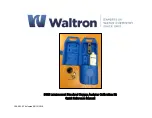
3
EX-B03E
INSTALLATION AND OPERATING PRECAUTIONS FOR TIIS FLAMEPROOF EQUIPMENT
6. Maintenance of Flameproof
Apparatus
To maintain the flameproof apparatus, do the following. (For
details, see Chapter 10 “MAINTENANCE OF EXPLOSION-
PROTECTED ELECTRICAL INSTALLATION” in the
USER’S GUIDELINES for Electrical Installations for
Explosive Gas Atmospheres in General Industry.)
(1) Maintenance servicing with the power on.
Flameproof apparatus shall not be maintenance-serviced with
its power turned on. However, in cases where maintenance
servicing is to be conducted with the power turned on, with
the equipment cover removed, always use a gas detector to
check that there is no explosive gas in that location. If it
cannot be checked whether an explosive gas is present or not,
maintenance servicing shall be limited to the following two
items:
(a) Visual inspection
Visually inspect the flameproof apparatus, metal
conduits, and cables for damage or corrosion, and other
mechanical and structural defects.
(b) Zero and span adjustments
These adjustments should be made only to the extent
that they can be conducted from the outside without
opening the equipment cover. In doing this, great care
must be taken not to cause mechanical sparks with tools.
(2) Repair
If the flameproof apparatus requires repair, turn off the
power and transport it to a safety (non-hazardous) location.
Observe the following points before attempting to repair the
apparatus.
(a) Make only such electrical and mechanical repairs as will
restore the apparatus to its original condition. For the
flameproof apparatus, the gaps and path lengths of joints
and mating surfaces, and mechanical strength of
enclosures are critical factors in explosion protection.
Exercise great care not to damage the joints or shock the
enclosure.
(b) If any damage occurs in threads, joints or mating
surfaces, inspection windows, connections between the
transmitter and terminal box, shrouds or clamps, or
external wiring connections which are essential in
flameproofness, contact Yokogawa Electric Corporation.
CAUTION
Do not attempt to re-process threaded connections or
refinish joints or mating surfaces.
(c) Unless otherwise specified, the electrical circuitry and
internal mechanisms may be repaired by component
replacement, as this will not directly affect the
requirements for flameproof apparatus (however, bear in
mind that the apparatus must always be restored to its
original condition). If you attempt to repair the
flameproof apparatus, company-specified components
shall be used.
(d) Before starting to service the apparatus, be sure to check
all parts necessary for retaining the requirements for
flameproof apparatus. For this, check that all screws,
bolts, nuts, and threaded connections have properly been
tightened.
(3) Prohibition of specification changes and
modifications
Do not attempt to change specifications or make
modifications involving addition of or changes in external
wiring connections.
7. Selection of Cable Entry De-
vices for Flameproof Type
IMPORTANT
The cable glands (cable entry devices for flameproof
type) conforming to IEC Standards are certified in
combination with the flameproof apparatus. So,
Yokogawa-specified cable entry devices for flameproof
type shall be used to meet this demand.
References:
(1) Type Certificate Guide for Explosion-Protected
Construction Electrical Machinery and Equipment
(relating to Technical Standards Conforming to Interna-
tional Standards), issued by the Technical Institution of
Industrial Safety, Japan
(2) USER’S GUIDELINES for Electrical Installations for
Explosive Gas Atmospheres in General Industry (1994),
issued by the Japanese Ministry of Labour, the Research
Institute of Industrial Safet





































